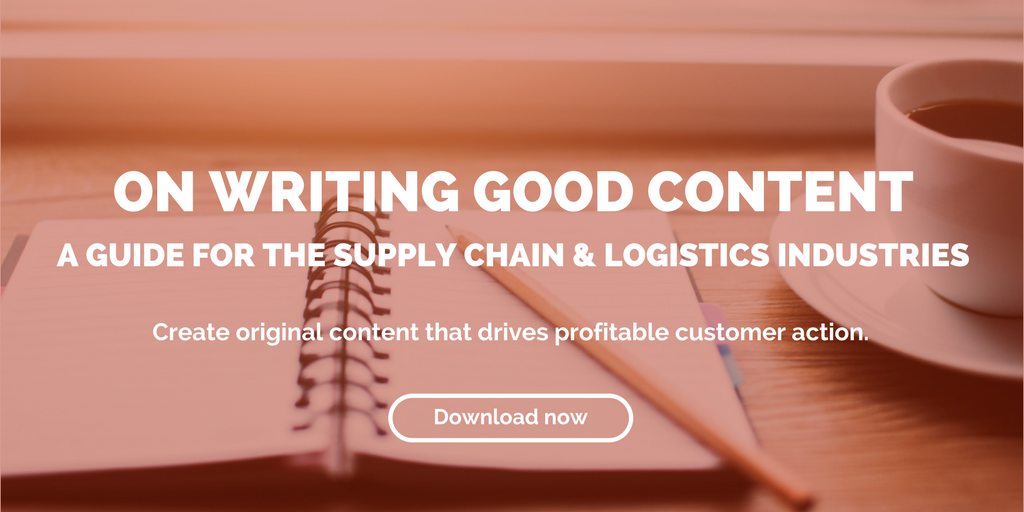
by Fronetics | Nov 1, 2018 | Blog, Content Marketing, Logistics, Manufacturing & Distribution, Marketing, Supply Chain
Case studies are a perfect way to organize and present hard facts about your products and services — and they continue to be one of the most effective types of content out there.
A recent study shows that case studies far outperform other types of content. The DemandGen 2017 Content Preferences Survey Report found that 78% of B2B buyers used vendor case studies as part of their purchasing decisions in the past 12 months. 89% of B2B marketers consider customer testimonials and case studies to be the most effective kind of content to convert buyers.
Buyers are looking to “benchmark their own experiences against others who’ve tackled similar challenges,” concluded DemandGen’s report. Data is powerful stuff, and buyers know it. In fact, DemandGen’s survey indicated 48% of buyers not only prefer case studies but find them to be the most valuable type of content for research. 57% even said that they would register and share information in exchange for case studies.
Why the case study?
Beyond the obvious answer that data is important to buyers, why do they respond so well to this type of content? According to Frank Cespedes, Senior Lecturer at Harvard Business School and author of Aligning Strategy and Sales, ultimately, buyers are less interested in theory than practice: “Buyers, especially B2B buyers, want to know what others are doing with your product, not what they might do to improve productivity or other outcomes.”
[bctt tweet=”Yes, case studies are highly effective, but their success is predicated on your reputation as a thought leader and source of knowledge and expertise.” username=”Fronetics”]
As a side-note, before you jump ship on aspects of your content marketing strategy, like blogs, social media, webinars, etc., that focus on sharing ideas rather than just data, consider this: even the most impactful case study is only as useful as the totality of your brand’s content. In other words, yes, case studies are highly effective, but their success is predicated on your reputation as a thought leader and source of knowledge and expertise.
What makes a case study effective?
Not all case studies are created equal. Data presented in a confusing or incomplete way, for example, doesn’t pack the kind of punch needed to demonstrate exactly how your products and services help your buyers. A good case study should prompt the reader to explore your brand and the rest of your content. Ultimately, the goal is to show your prospect that making a change in their process will lead to better results.
As you design a case study, think about giving buyers the tools to present your products and services to decision-makers within their business. “Especially in B2B contexts,” says Cespedes, “buyers must justify a decision to others in the organization who have competing priorities for limited funds.” This is where a compelling case study comes in. Show your potential buyers how other organizations benefit from your offerings, and they have the tools to make a case for your business.
Case studies are proven to be well worth the time and energy needed to produce them. Recommendations and data from real customers have a powerful impact and should continue to be a significant component of your overall content marketing strategy.
Related posts:


by Fronetics | Aug 22, 2018 | Blog, Content Marketing, Logistics, Manufacturing & Distribution, Marketing, Strategy, Supply Chain
Account-based marketing has traditionally utilized outbound marketing tactics, until now.
Account-based marketing has been around for decades, but it has been gaining a lot of attention in the past few years. More and more companies are starting to use account-based marketing to increase their brand awareness with specific audiences and work together with sales teams to close deals.
But what is account-based marketing?
Account-based marketing
Account-based marketing (ABM) is a focused approach to B2B marketing in which marketing and sales teams work together to target best-fit accounts and turn them into customers. Marketers and sales teams focus their efforts on specific accounts — companies, customers, target audiences — and work to get marketing materials in front of them.
Essentially, account-based marketing takes a potential customer and turns them into their own market. “[ABM] is to address the needs of organization by connecting with all of the stakeholders within it. That’s one reason why it works so well in B2B — oftentimes you have to work with five or more stakeholders in a given sale,” writes Sam Balter, HubSpot’s Corporate Marketing Manager.
So how can content marketing help with ABM, which has traditionally been a sales strategy?
Content marketing and account-based marketing
Inbound marketing focuses on audiences finding you. Instead of pushing a message onto buyers, inbound marketing allows you to establish your brand as an industry leader and let interested audiences come to you. This type of marketing attempts to draw in potential customers through interesting and engaging content.
Content marketing is a type of inbound marketing that uses blog posts, social media, infographics, and video to expose target audiences to a brand.
Merging sales and marketing efforts
There’s no reason that ABM and content marketing can’t work together. In fact, you’re missing out on maximizing your marketing efforts if you aren’t incorporating both of these marketing strategies in your overall marketing plan.
[bctt tweet=”Traditional sales pitches are no longer pushing buyers down the sales funnel. Instead, buyers want a personalized experience, where they feel they are getting to know a brand before they make a buying decision.” username=”Fronetics”]
Today’s buyers don’t want to be ‘sold.’ Traditional sales pitches are no longer pushing buyers down the sales funnel. Instead, buyers want a personalized experience, where they feel they are getting to know a brand before they make a buying decision.
What does this mean for your ABM strategy? It means that content marketing can help educate and inform the specific accounts your sales team has identified through valuable, interesting content.
“For example, if you approach any content you create as part of the strategy with both goals in mind, you can create a piece of content that is both incredibly useful from a keyword perspective (and drives a ton of traffic to your site) while also providing all the key information that you’d like to say to your ABM contacts,” writes Stacy Willis for Impact.
When creating content for any marketing effort, the key is to make sure that your content has value. Whether you’re trying to attract a specific account or looking to increase web traffic, content marketing focuses on value and not just volume.
Creating a cohesive account-based marketing and inbound marketing strategy will help maximize your marketing efforts. Though not traditionally used together, it’s time to think outside the box and start seeing the benefits of a joint marketing approach.
Related posts:


by Fronetics | Jul 2, 2018 | Blog, Content Marketing, Logistics, Marketing, Social Media, Supply Chain
The growth of social messaging platforms is a big opportunity for your business to reach your audience with targeted content.
Gone are the days when social messaging platforms are just about chatting or making plans with family and friends. You might be surprised to learn that “the combined total monthly active user count of the top 4 messaging apps has grown to 4.1 billion in 2018.”
[bctt tweet=”You might be surprised, according to Business Insider, “the combined total monthly active user count of the top 4 messaging apps has grown to 4.1 billion in 2018.”” username=”Fronetics”]
Just to put that in perspective, that’s well over half of the world’s population and — perhaps even more strikingly — dwarfs the 2.19 billion monthly active users that Facebook reported in the first quarter of 2018.
It’s official: Social messaging platforms have surpassed “traditional” social media when it comes to active users. Not only that, marketers are taking notice, and beginning to think about how to leverage messaging platforms to deliver content to target audiences.
Conversational content
As you might expect, a key element of successfully using social messaging platforms is to tell your story conversationally. This means tailoring your content to the specific wants or needs of your target audience, creating a compelling narrative with your content, rather than an overt sales pitch.
This kind of storytelling is fundamental to content marketing.
“Messaging and chatbots represent the next logical extension of the content marketing mission,” writes Chris Frascella of the Content Marketing Institute.
According to Thomas Husson of Forbes, “Messaging apps will introduce a paradigm shift for marketers where interactive and contextual conversations will replace ad broadcasting. New conversational interfaces will drive deeper relationships between consumers and brands.”
You may be thinking that this is all well and good for B2C marketing, but how does it apply to B2B marketing? But the truth is, if you have a content marketing strategy in place, chances are, you have a story to tell, and these are tools to help you do it.
Chatbots
Enter chatbots, the technology to turn your content into conversations. Chances are, you’ve already come face-to-screen with a chatbot and may not have even known it.
These computer programs simulate human conversation using auditory or textual methods. Basically, it’s software that communicates with your target audience inside a messaging app. Chatbots are already changing the way businesses interact with their customers — and with each other.
If you’re thinking that you’re about to be replaced by a robot, relax. We’re extremely far from AI technology replacing human interaction. Chatbots are a tool, and they need to be fed content and trained by human marketing professionals.
Tips for using chatbots
The first step is adapting your content for use in a chatbot conversation. “You can’t just duplicate existing content in your conversational scripts,” says Frascella. While the goals for your content are the same, the way it is delivered is different. That requires a shift in how it’s structured.
It’s also important to be mindful of timing. Because chatbots require users to opt into conversations, retaining permission to access your audience in this way depends largely on content and timing. This means delivering engaging, meaningful, and valuable content at regular intervals, but not intrusively.
For more ideas on creating a chatbot, check out this post.
Social messaging platforms are opening new doors for you to deliver personalized content straight to your target buyers. Make the most of this opportunity!
Related posts:


by Fronetics | May 10, 2018 | Blog, Content Marketing, Logistics, Marketing, Supply Chain
An important part of your content strategy should be optimizing historic blog content to ensure it’s attracting as much traffic as possible.
We all know that creating original content on a regular basis is important to improving SEO and attracting organic traffic to your website. But, here’s a surprise: Most of your traffic will come from older blog posts.
An important part of your content strategy should be optimizing historic blog content to ensure it’s attracting as much traffic as possible.
If you have a lot of content, that may scare you. (Sounds like a lot of work!) But, as with everything, being strategic about optimizing historic blog content will pay off many times over. Here’s how I suggest going about that.
Pick your posts
At Fronetics, about 80% of our traffic comes from posts that are 6 months old or older. HubSpot also discovered a similar trend: 76% of its monthly views came from old posts, as well as 92% of the company’s monthly leads!
[bctt tweet=”76% of HubSpot’s monthly views come from old posts and 92% of their monthly leads.” username=”Fronetics”]
But not all posts were created equal. In fact, HubSpot found they got about half of their monthly leads from only 30 posts, and they blog at a blistering pace of about 200 new posts every month. Going back and optimizing hundreds of your old posts is a waste of time.
Hunt through your analytics and look for historical blog posts with:
- High traffic and high conversion rates: Readers view these posts often and convert frequently after reading them. Found any of these? Congrats. Most companies won’t have more than 1 or 2.
- High traffic but low conversation rates: These are the posts are viewed often but don’t generate leads.
- Low traffic but high conversion rates: These posts only garner a small number of hits but do well generating leads due to a higher-than-normal number of call-to-action click-throughs.
All set? Have a list of good blogs to work with? Here comes the fun part!
5 tips for optimizing historic blog content
Here are 5 tips to squeeze the absolute most out of your older blog posts (in terms of leads and conversions).
1. Update the content.
Rework it for today. Take out anything outdated and use a little finesse to make it more relevant. Don’t overhaul it; that’s unnecessary for a well-performing post.
2. Spice up the call-to-actions.
You’ll want to pay special attention to this for the posts that have high traffic but low conversion rates. CTAs have evolved. Old ones just aren’t going to appeal.
Revamp the CTA placement and appearance, and think (hard) again about your CTA content. Consider the language of the CTA and whether it fits the reader’s goal. What keyword(s) are they using to find the page? And does the CTA reflect this?
There’s so much information out there on making strong CTAs, but the bottom line is the CTA must match the intent of the audience.
Keep it bold. Keep it clear. And make ‘em an offer they can’t refuse.
3. Relook at your keywords.
For the posts that do well converting leads but don’t get a lot of traffic, you’ll need to take a fresh look at keywords.
Trying to rank for certain keywords in each blog post you publish is a practice on the way out. But it still has merit here, as long as you understand it within the larger picture of restructuring your website content into topic clusters and pillar content.
People are changing how they search, and search-engine-optimizing these old posts to get more visibility is the goal.
And here’s the beauty of optimizing historical blog content: You already have the data to know which keywords your audience are using to find the posts. Then prominently feature the keyword(s) in several places.
4. Update your posts’ meta descriptions.
If you’ve done the hard work to update the CTA and the keywords, updating the meta description is a natural next step. Keep it as close to (but not over) 155-165 characters. Include your keyword(s). Explain the value of the post to the reader. And keep in mind your ultimate CTA goal. Everything should align to make the meta description a true synthesis of the post; if it doesn’t, go back and tweak a little more.
5. Republish and keep the URL.
Things that are “fresh” receive preferential treatment from Google. (We know it’s hard to believe when 2012 articles are at the top of your search results, but it’s true.)
But do not lose that original URL when you publish again. It pulls way more SEO “rank” than a new one. Keep the URL even if you updated the title of the post and the URL doesn’t match perfectly anymore. It’s OK.
(It’s not a bad idea to put in an editor’s note at the end of the article if the blog already has garnered comments, so your future audience won’t be confused by a publish date that is later than the date on the comments.)
And that’s it. 30 days after optimizing your historic blog content, go back and see how successful your efforts were. Track the metrics: post views, CTA click-throughs, lead generation, and keyword ranking. We’re betting they’ve gone up.
Measuring the success of your SEO strategy shouldn’t be done by measuring the success of one post at a time. But making the most of your best old posts is an important part of any good content marketing strategy.
Final tip
The final tip isn’t really about optimizing historic blog content, so let’s call it a ½ tip. Remember how Tip 1 recommended reworking the old posts but warned against overhauling them with large rewrites?
Well… Here’s the thing. If you have 12 historic blog posts you just optimized, you should write 12 new blog posts on that same content, too.
Recycle that good historic content into additional fresh content. After all, it’s what your audience is searching for!
Related posts:


by Fronetics | May 1, 2018 | Blog, Content Marketing, Logistics, Marketing, Strategy, Supply Chain
Use these three steps to calculate content marketing ROI to show the value of your investment.
As supply chain and logistics businesses are finally recognizing the merits of content marketing, many are looking into it. But it doesn’t take much research to realize what an enormous investment it is. And how difficult it can be to calculate content marketing ROI.
[bctt tweet=”A data-driven approach to calculating Content Marketing ROI lets you continually adapt to the needs of your audience, ensuring an ongoing, robust ROI.” username=”Fronetics”]
Many companies we talk to need help convincing management that it’s a worthwhile investment. To that we say, use data!
But what data should you use? How do you quantify certain benefits, like growth in brand awareness? And do you really have to keep track of all the hours you spend writing blog posts, managing social media, etc.?
Here are three basic steps for how to calculate content marketing ROI.
3 steps to calculate content marketing ROI
1) Set up your ROI measurement.
It’s important that you measure content marketing ROI at the initiative level. This means calculating the ROI of your blog, your webinar series, your Facebook marketing, etc. individually.
After calculating the ROI of each initiative, you can aggregate that data to determine your overall content marketing ROI for your business.
2) Know as much detail as possible.
“To measure ROI, you have to know, in as much detail as possible, the R (return) and the I (investment) of your content initiative,” says Jay Baer, president of Convince & Convert. Baer walks his readers through the example of figuring out ROI for a podcast, including calculating total investment in the project (including preparation and execution), and calculating total return.
Content marketing is about creativity. By the same token, think creatively about every measurable avenue of return in each of your initiatives.
3) Calculate your ROI.
The formula for ROI is universal: return minus investment, divided by investment, expressed as a percentage.
And there’s some good news for supply chain and logistics content marketing: “Content marketing ROI calculations are indeed easier for B2B companies because they almost always have visibility at the transaction layer,” writes Baer.
Once you’ve calculated ROI for each of your major initiatives, it’s time to think strategically about optimizing your content marketing resources, in terms of allocation and timing. Having hard data helps you answer questions about which initiatives are most fruitful, what language engages your audience best, when your efforts are most likely to pay off.
Ultimately, this data-driven approach lets you continually adapt to the needs of your audience, ensuring an ongoing, robust ROI.
Related posts:










